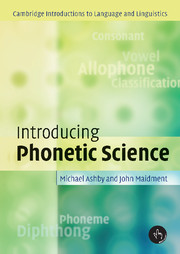6 - Voice II
Published online by Cambridge University Press: 05 June 2012
Summary
CHAPTER OUTLINE
In this chapter you will learn about: aspiration; aspiration and devoicing in English; the use of aspiration in languages of the world; larynx waveforms for normal voice and other phonation types; voice onset time and how to measure it.
KEY TERMS
Aspiration
Breathy voice
Devoicing
Fortis
Lenis
Modal voice
Phonation type
VOT (voice onset time)
Introduction
As we saw in Chapter 2, one important way in which consonant sounds may differ from one another is by voicing. However, it is important to be aware that the terms ‘voiced’ and ‘voiceless’ do not simply refer to the presence or absence of vocal fold vibration. The articulatory and acoustic events that give rise to the perception of voicing and voicelessness are somewhat more complex than the simple story we told in Chapter 2. What counts as voiced in one language may, in some instances, be perceived as voiceless in another language. In this chapter we look at the topic of voicing in more detail and consider the importance of the timing of the onset of vocal fold vibration in relation to other articulatory events. We also look in more detail at vocal fold vibration itself, and distinguish normal voice from other phonation types.
Voice Onset Time
For voiceless plosive consonants, vocal fold vibration is stopped for a period that is a little longer than the hold phase (the time when the mouth is blocked, see Chapter 4), so that there is still no vocal fold vibration around the moment of release (when the articulators part and the plosion is heard) and possibly for a further brief time afterwards.
- Type
- Chapter
- Information
- Introducing Phonetic Science , pp. 91 - 102Publisher: Cambridge University PressPrint publication year: 2005



